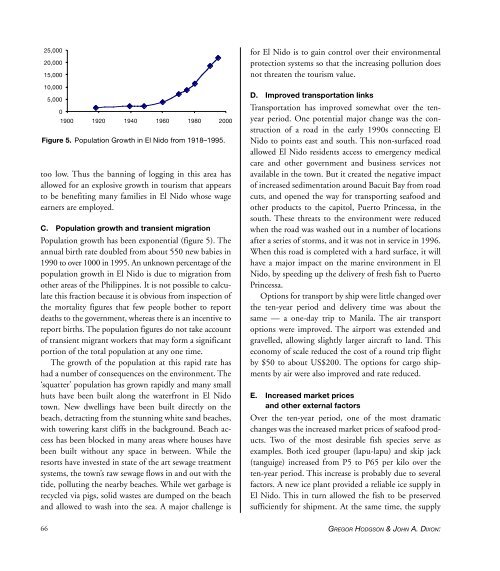Create successful ePaper yourself
Turn your PDF publications into a flip-book with our unique Google optimized e-Paper software.
25,000<br />
20,000<br />
15,000<br />
10,000<br />
5,000<br />
0<br />
1900 1920 1940 1960 1980 2000<br />
Figure 5. Population Growth in El Nido from 1918–1995.<br />
too low. Thus the banning <strong>of</strong> logging in this area has<br />
allowed for an explosive growth in tourism that appears<br />
to be benefiting many families in El Nido whose wage<br />
earners are employed.<br />
C. Population growth and transient migration<br />
Population growth has been exponential (figure 5). The<br />
annual birth rate doubled from about 550 new babies in<br />
1990 to over 1000 in 1995. An unknown percentage <strong>of</strong> the<br />
population growth in El Nido is due to migration from<br />
other areas <strong>of</strong> the Philippines. It is not possible to calculate<br />
this fraction because it is obvious from inspection <strong>of</strong><br />
the mortality figures that few people bother to report<br />
deaths to the government, whereas there is an incentive to<br />
report births. The population figures do not take account<br />
<strong>of</strong> transient migrant workers that may form a significant<br />
portion <strong>of</strong> the total population at any one time.<br />
The growth <strong>of</strong> the population at this rapid rate has<br />
had a number <strong>of</strong> consequences on the environment. The<br />
‘squatter’ population has grown rapidly and many small<br />
huts have been built along the waterfront in El Nido<br />
town. New dwellings have been built directly on the<br />
beach, detracting from the stunning white sand beaches,<br />
with towering karst cliffs in the background. Beach access<br />
has been blocked in many areas where houses have<br />
been built without any space in between. While the<br />
resorts have invested in state <strong>of</strong> the art sewage treatment<br />
systems, the town’s raw sewage flows in and out with the<br />
tide, polluting the nearby beaches. While wet garbage is<br />
recycled via pigs, solid wastes are dumped on the beach<br />
and allowed to wash into the sea. A major challenge is<br />
for El Nido is to gain control over their environmental<br />
protection systems so that the increasing pollution does<br />
not threaten the tourism value.<br />
D. Improved transportation links<br />
Transportation has improved somewhat over the tenyear<br />
period. One potential major change was the construction<br />
<strong>of</strong> a road in the early 1990s connecting El<br />
Nido to points east and south. This non-surfaced road<br />
allowed El Nido residents access to emergency medical<br />
care and other government and business services not<br />
available in the town. But it created the negative impact<br />
<strong>of</strong> increased sedimentation around Bacuit Bay from road<br />
cuts, and opened the way for transporting seafood and<br />
other products to the capitol, Puerto Princessa, in the<br />
south. These threats to the environment were reduced<br />
when the road was washed out in a number <strong>of</strong> locations<br />
after a series <strong>of</strong> storms, and it was not in service in 1996.<br />
When this road is completed with a hard surface, it will<br />
have a major impact on the marine environment in El<br />
Nido, by speeding up the delivery <strong>of</strong> fresh fish to Puerto<br />
Princessa.<br />
Options for transport by ship were little changed over<br />
the ten-year period and delivery time was about the<br />
same — a one-day trip to Manila. The air transport<br />
options were improved. The airport was extended and<br />
gravelled, allowing slightly larger aircraft to land. This<br />
economy <strong>of</strong> scale reduced the cost <strong>of</strong> a round trip flight<br />
by $50 to about US$200. The options for cargo shipments<br />
by air were also improved and rate reduced.<br />
E. Increased market prices<br />
and other external factors<br />
Over the ten-year period, one <strong>of</strong> the most dramatic<br />
changes was the increased market prices <strong>of</strong> seafood products.<br />
Two <strong>of</strong> the most desirable fish species serve as<br />
examples. Both iced grouper (lapu-lapu) and skip jack<br />
(tanguige) increased from P5 to P65 per kilo over the<br />
ten-year period. This increase is probably due to several<br />
factors. A new ice plant provided a reliable ice supply in<br />
El Nido. This in turn allowed the fish to be preserved<br />
sufficiently for shipment. At the same time, the supply<br />
66<br />
GREGOR HODGSON & JOHN A. DIXON:


















